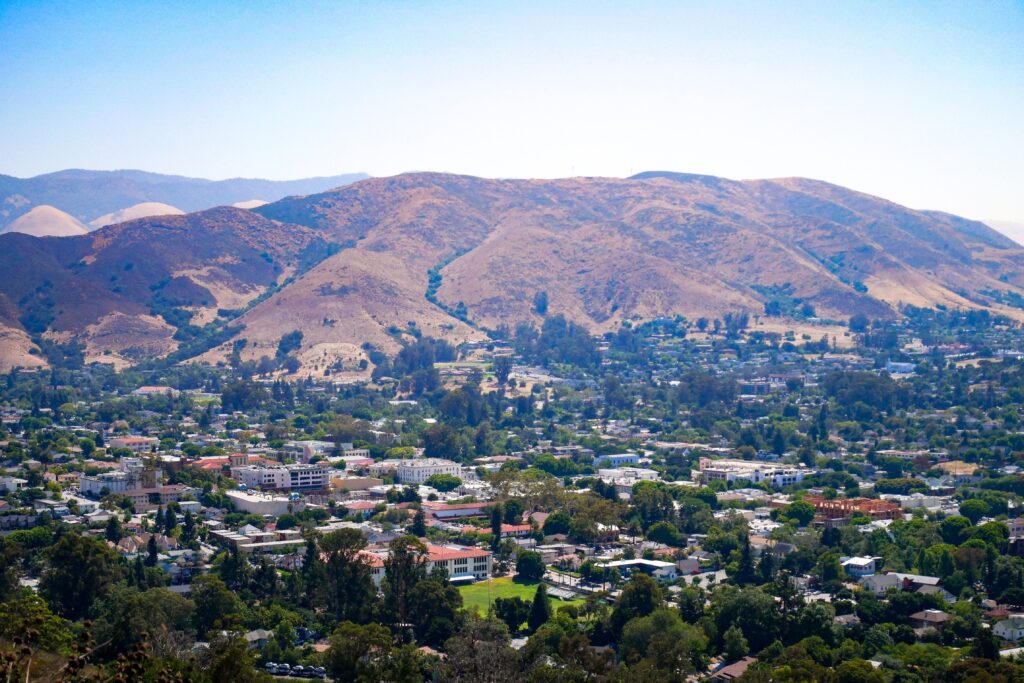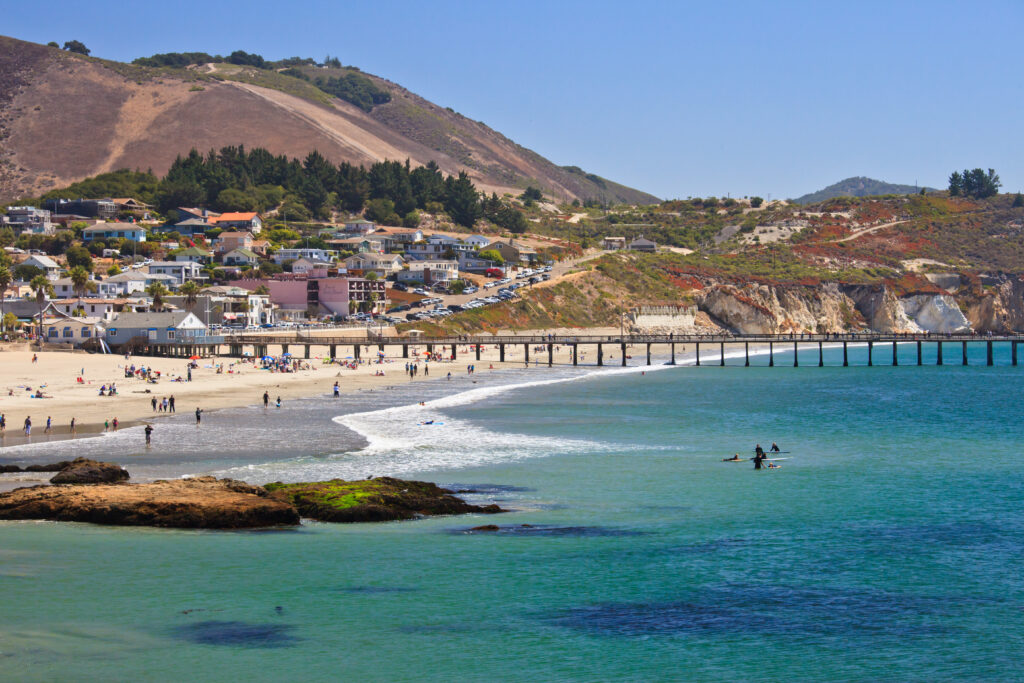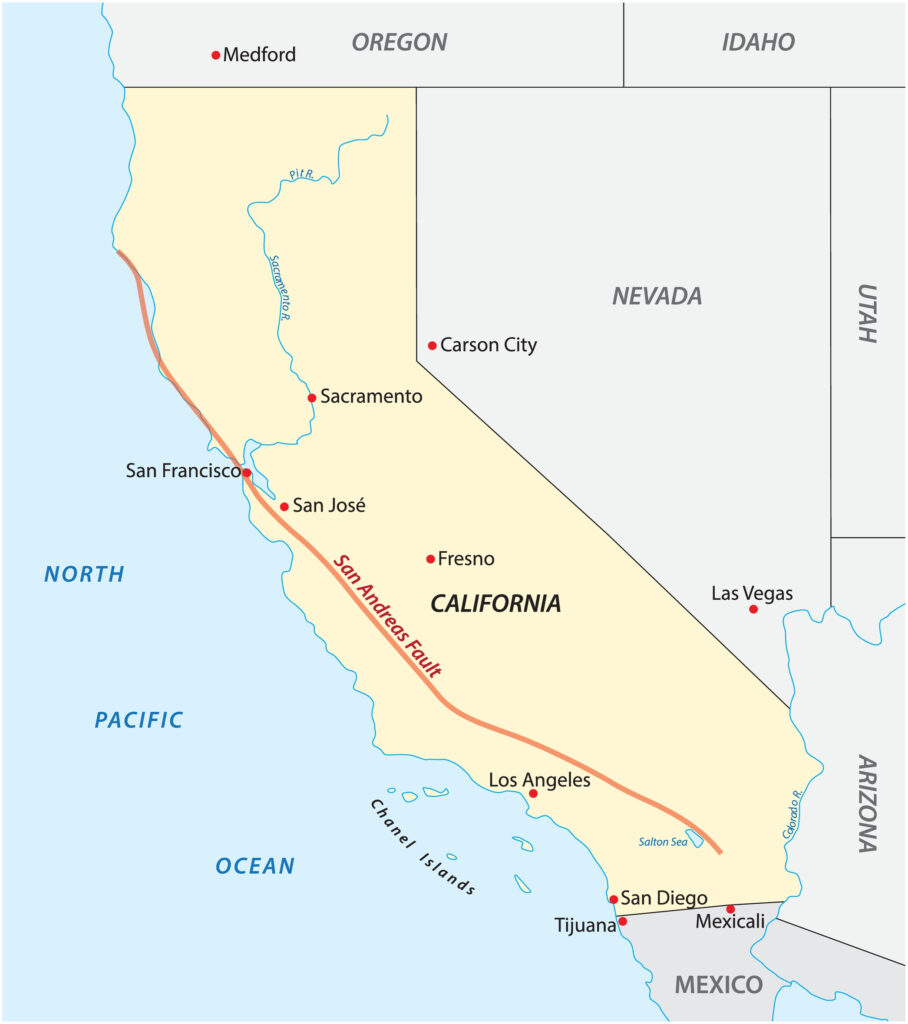For several decades, nuclear power plants have been a significant energy source for electricity production for many countries worldwide.
These plants use nuclear reactions to generate heat that boils water and creates steam to drive turbines, generating electricity.
This article reveals California‘s largest nuclear power plant and what lives around it. We also take you for an informative ride on everything you need to know about nuclear power plants.
The Largest Nuclear Power Plant in California

San Luis Obispo County is located on California’s Central Coast.
©joojoob27/Shutterstock.com
The Diablo Canyon Power Plant (DCPP) is California’s largest nuclear power plant. It has two nuclear reactors located in San Luis Obispo County on California’s central coast. Their combined capacity is 2,240 megawatts.
The DCPP has been a significant energy source for California since it began operating in 1985. As the state’s only remaining nuclear power plant, DCPP provides electricity to millions of homes and businesses.
But the plant has also been the subject of controversy and safety concerns, with some advocates calling for its closure due to the risks associated with nuclear energy.
The Power Plant’s History
The DCPP has a rich history of controversy, protests, and safety concerns. Let’s dive into the plant’s past and explore the events that led to its construction and operation.
Early Development and Construction
In the late 1960s, Pacific Gas and Electric first began exploring the possibility of constructing a nuclear power plant on California’s central coast.
After securing a site near Avila Beach in 1971, construction began in earnest in 1973.
Safety Concerns and Protests
The construction of the Diablo Canyon Power Plant was not without its challenges.
In 1976, a group of protesters known as the Abalone Alliance staged a two-week sit-in at the plant site. They called for an end to nuclear power plants in California.
The sit-in ended in over 1,900 arrests, making it one of the largest acts of civil disobedience in U.S. history.
Throughout the 1970s and 1980s, safety concerns surrounding the plant continued to mount. The plant’s critics cited its proximity to several earthquake fault lines, its location near the ocean, and the potential risk of tsunamis.
Operation and Maintenance
Despite these safety concerns, the DCPP began operating in 1985, with two pressurized water reactors designed to produce a combined 2,240 megawatts of electricity.
Over the years, the plant underwent routine maintenance and safety inspections, including:
- Seismic retrofits
- Upgrades to the cooling systems
But safety concerns continue to be raised, with some advocates calling for the plant’s closure due to the risks associated with nuclear energy.
Technical Aspects of the Plant

Nuclear power plants extract uranium ore from mines during the fuel cycle.
©Nostal6ie/Shutterstock.com
Let’s take a closer look at the technical aspects of a nuclear power plant and how it operates.
Reactor Design
The plant was designed with two pressurized water reactors (PWRs), each with a capacity of 1,120 megawatts of electricity.
Nuclear Fuel Cycle
The plant’s nuclear fuel cycle involves the extraction of uranium ore from mines. It’s then transported to a conversion facility and converted into uranium hexafluoride.
The uranium hexafluoride is then enriched in a gas centrifuge to increase the concentration of uranium-235, the isotope used for nuclear fuel.
The enriched uranium is fabricated into fuel rods and inserted into the reactor core. The fuel rods generate heat through nuclear fission. The heat is used to create steam to power turbines and generate electricity.
Cooling Systems
The plant’s cooling systems are critical to its safe operation. The plant uses ocean water as a coolant. It’s drawn in through a system of intake pipes and sent to a heat exchanger to cool the water used in the reactor.
The cooling water is then discharged back into the ocean, with measures taken to minimize its impact on marine life and the environment.
Additionally, the plant has emergency backup cooling systems in the event of a loss of power or other critical failures.
Waste Management
One of the biggest challenges associated with nuclear energy is managing radioactive waste. The plant produces spent fuel rods that are stored on-site in dry casks.
These casks are designed to safely store the spent fuel for decades or even centuries until a permanent disposal solution is found.
Nuclear waste management and disposal continue to be a debate and concern among advocates for and against nuclear energy.
Safety Measures and Precautions
Safety measures and precautions are paramount at the DCPP. So let’s take a closer look at the various measures put in place to ensure the safe operation of the plant.
Emergency Preparedness
The plant has detailed emergency preparedness plans for a nuclear accident or other emergencies. The plans involve a coordinated response with local, state, and federal agencies to ensure the safety of the public and plant workers.
The plant conducts regular drills and exercises to test the emergency plans and ensure that all staff are familiar with their emergency roles.
Radiation Protection
The plant also has extensive measures to protect workers and the public from radiation exposure. These measures include:
- Strict protocols for handling radioactive materials
- Regular monitoring of radiation levels in the plant and surrounding area
- Using protective gear and equipment by workers
Additionally, the plant has a comprehensive radiation monitoring program to ensure that any releases of radioactive material are detected and managed quickly and effectively.
Regulatory Oversight
The DCPP is subject to extensive regulatory oversight from state and federal agencies. In addition, the Nuclear Regulatory Commission ensures that the plant operates safely and complies with all regulations and standards.
The plant undergoes regular inspections and audits to meet all safety requirements and promptly address any issues or concerns.
Additionally, the plant has an independent oversight panel of local citizens and experts to provide additional oversight and input on safety and environmental issues.
Environmental Impact of the Plant
The plant significantly impacts the environment, both during its construction and operation.
Local Ecosystem
The plant was constructed on California’s central coast, home to a diverse ecosystem of plants and animals. Unfortunately, the plant’s construction required significant excavation and grading, resulting in many species losing their habitat.
Additionally, the plant’s operation requires the intake and discharge of large seawater quantities. This can have a detrimental impact on local marine life.
The plant takes measures to mitigate the impact of its water intake and discharge, including screens to prevent fish from being drawn into its cooling systems.
Water Usage
The plant is water-intensive, requiring large quantities of water for cooling purposes. Using seawater for cooling can significantly impact the local marine environment. In addition, it can result in the release of heated water and potentially harmful chemicals.
The plant’s water usage has also contributed to regional scarcity, particularly during drought.
Greenhouse Gas Emissions
While nuclear power is often touted as a clean energy source, the plant’s construction and operation significantly impact greenhouse gas emissions. The construction required using heavy equipment and vehicles, resulting in significant carbon emissions.
The plant also requires fossil fuels for backup power generation and other purposes.
While the plant doesn’t emit carbon dioxide or other greenhouse gases during normal operation, its reliance on fossil fuels for backup power can significantly impact the environment.
Human Population Around the Power Plant

Avila Beach is a popular tourist destination in Central California.
©Juancat/Shutterstock.com
The plant is located near a significant human population. Therefore, let’s examine the impact of the plant on the local human population.
Safety Concerns
One of the primary concerns of the local population around the plant is safety. The plant is located near several active fault lines. Moreover, concerns over seismic activity and potential nuclear accidents are prevalent in the area.
The plant takes numerous safety measures to address these concerns, including:
- The installation of advanced earthquake detection and monitoring systems
- The construction of a tsunami wall to protect against potential tidal waves
However, safety concerns have persisted among some members of the local population.
Employment Opportunities
The plant provides significant employment opportunities for the local population. Hundreds of workers are employed at the facility during its operation. The plant provides jobs in various fields, including:
- Engineering
- Maintenance
- Security
The plant also benefits the local community economically by purchasing goods and services from local businesses.
Economic Impact
The plant has a significant impact on the local economy. It provides jobs and economic benefits to the surrounding community. It also contributes to the state’s energy grid, providing clean and reliable energy to millions of Californians.
Wildlife Found Around the Power Plant

Seas lions, dolphins, and other wildlife species live near the largest nuclear power plant in California.
©Daniel Avram/Shutterstock.com
The plant is located near various wildlife habitats. This makes the impact of the plant on the surrounding ecosystem a vital consideration. Let’s examine the impact of the plant on wildlife in the area and the plant’s efforts to mitigate this impact.
Habitats and Wildlife
The plant is uniquely located, with various habitats and wildlife in the surrounding area. It’s located near the Pacific Ocean, with several creeks and waterways running through it. The region is home to various wildlife species, including sea lions, dolphins, and numerous bird species.
Impact of the Plant
The plant has a significant impact on the local area wildlife. Its operation can warm seawater used for cooling. This can affect marine habitats and cause the death of numerous fish and other marine life.
Additionally, the construction of the plant and its associated infrastructure resulted in the loss of some wildlife habitats.
Mitigation Efforts
The plant has implemented numerous mitigation efforts to address its impact on local wildlife. It works to minimize the amount of seawater it uses for cooling, reducing the impact on marine life.
The plant has also implemented numerous measures to reduce noise pollution and disturbance to local wildlife habitats, including:
- The installation of sound barriers
- The establishment of protected areas around the plant
Additionally, the plant works closely with local conservation organizations and government agencies to monitor the impact of its operation on the surrounding ecosystem and make necessary adjustments to its operations.
The Plant’s Seismic Risk

The Diablo Canyon Nuclear Power Plant is located near the San Andreas fault.
©Rainer Lesniewski/Shutterstock.com
Among the biggest concerns with the plant is its proximity to the San Andreas Fault and the potential for seismic activity.
Let’s examine the seismic risk associated with the plant and the measures taken to ensure its safety.
Seismic Risk
The plant was built in an area known for its seismic activity, with the potential for earthquakes being a significant concern. Therefore, it was designed to withstand the maximum expected earthquake, which was determined based on extensive seismic studies of the area.
But the potential for earthquakes beyond the maximum expected earthquake remains a concern, as the seismic activity in the region is difficult to predict.
Additionally, the plant was built on a shoreline fault. This raises further concerns about the plant’s safety during a seismic event.
Safety Measures
The plant has implemented numerous safety measures to ensure its safety during a seismic event. In designed with redundant safety systems and backup power supplies to ensure that critical systems continue running in case of a power outage or other disruptions.
Also, the plant’s design can withstand a significant amount of ground motion, with special attention paid to the safety of its cooling system.
The plant’s cooling system is also designed to remain operational even during an earthquake, helping to prevent a potential meltdown.
The plant has also implemented an extensive seismic monitoring system to track seismic activity in the region and detect any potential threats to the plant’s safety.
Finally, the plant works closely with local and national seismic experts to monitor its safety and make necessary adjustments to its operations to ensure its continued safety.
The Future of the Power Plant
The plant has been controversial in California due to concerns about its safety and environmental impact.
Let’s examine the plant’s future, including its planned retirement and potential replacement with renewable energy sources.
Retirement Plan
In 2016, the California Public Utilities Commission approved a plan to retire the plant by 2025. The decision was based on concerns about the safety risks associated with the plant’s location and the increasing costs of operating a nuclear power plant.
The retirement plan includes a transition to renewable energy sources to replace the energy generated by the plant. The transition to renewable energy is expected to create new job opportunities and stimulate the region’s economic growth.
Replacing the Plant with Renewable Energy
The plant’s retirement allows California to accelerate its transition to renewable energy sources. The state plans to reduce greenhouse gas emissions and transition to a carbon-free electricity system. It aims to achieve 100% clean energy by 2045.
To replace the energy generated by the plant, California is investing in a mix of renewable energy sources (like solar and wind) and energy storage. The state is also working to modernize its grid infrastructure to integrate renewable energy sources better and ensure a reliable and resilient electricity system.
The transition to renewable energy sources offers numerous benefits for California and the wider region. First, the sources are cleaner and more sustainable than fossil fuels.
Additionally, renewable energy sources can provide economic benefits, such as job creation and increased economic activity. The growth of the renewable energy industry can also stimulate innovation and technological development, helping to drive the transition to a more sustainable energy system.
Where is San Luis Obispo County Located on a Map?
San Luis Obispo County, officially known as the County of San Luis Obispo, is a coastal county located in central California. With a population of 282,424 according to the 2020 census, it is home to the city of San Luis Obispo, which serves as the county seat. The area’s history traces back to 1772 when Junípero Serra established the Mission San Luis Obispo de Tolosa, laying the foundation for the growth and development of the city of San Luis Obispo.
Here is San Luis Obispo County on a map:
Key Takeaways
While the DCPP has provided a reliable energy source for California, concerns about its safety and environmental impact have led to calls for its retirement.
Despite these concerns, the plant has been an important energy source for California, helping power homes and businesses throughout the state. It has also provided economic benefits, including job creation and increased economic activity.
But with the plant’s retirement in 2025, California can accelerate its transition to renewable energy sources and achieve its ambitious clean energy goals. The transition to renewable energy offers numerous benefits, including reduced greenhouse gas emissions, increased economic activity, and technological development.
As California continues to pursue a sustainable energy future, the plant’s lessons can help to inform the design and operation of future energy infrastructure. By investing in renewable energy sources, modernizing its grid infrastructure, and prioritizing safety and environmental considerations, California can lead the way to a more sustainable energy system.
The photo featured at the top of this post is © Doc Searls from Santa Barbara, USA/CC BY-SA 2.0 – License / Original
Thank you for reading! Have some feedback for us? Contact the AZ Animals editorial team.






